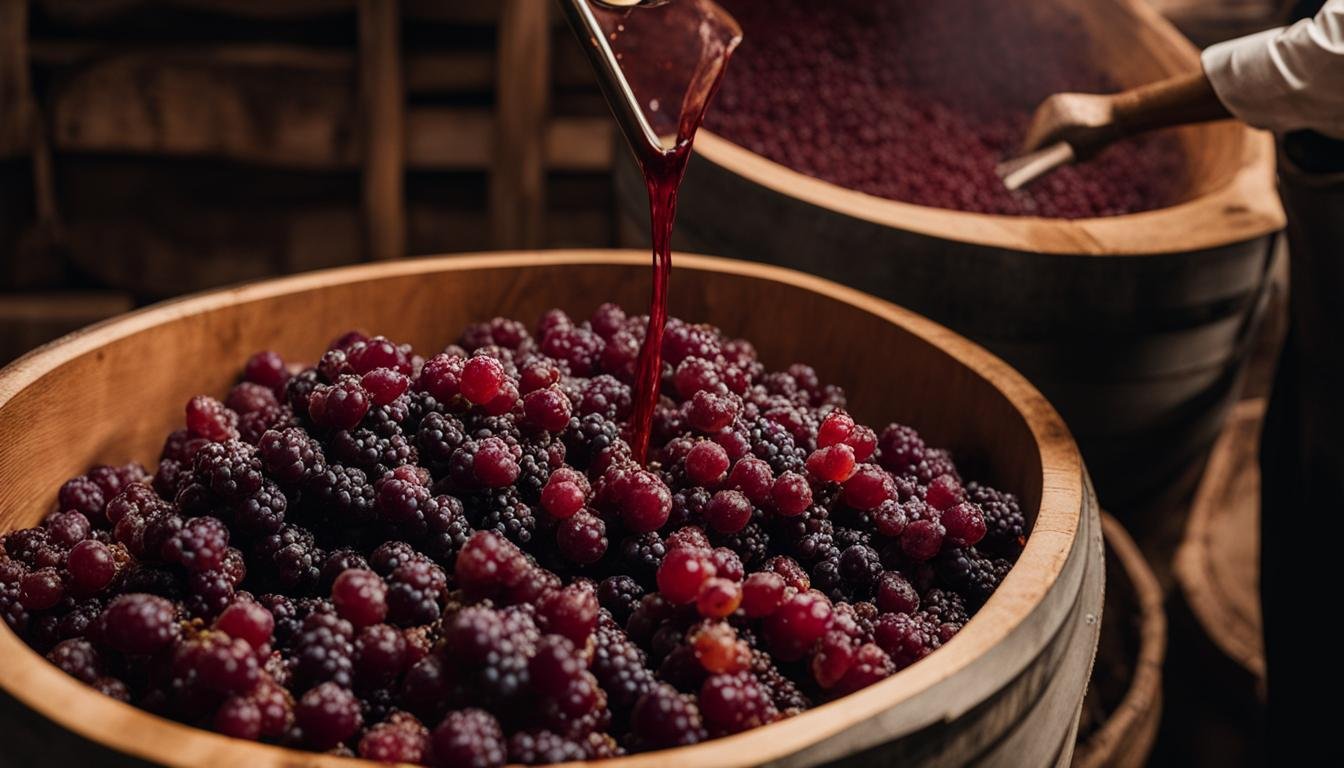This post may contain affiliate links. Please read my disclosure policy.
Ever wondered about that drying, puckering sensation when you sip on a glass of red? That’s your introduction to tannins in wine. Derived from grape skins, these naturally occurring compounds play a huge role in the taste, texture, and ageing potential of a wine. Tannins give wine its astringency, creating that dry, mouth-puckering feeling you recognise in tannic wines like Shiraz, Cabernet Sauvignon, and Nebbiolo.
Tannins are essential to a wine’s structure and body. They significantly contribute to how a wine matures. Understanding tannins in wine helps you appreciate the complexity of your favourite tipple, enhancing your tasting and pairing experiences. Whether you’re trying a Barossa Valley Shiraz or a Hunter Valley Semillon, tannins add that extra layer of enjoyment to your wine journey.
The Essential Role of Tannins in Wine Making and Enjoyment
How to Sense Tannins in Your Wine
Tannins offer a distinctive sensory experience in wine, especially red wine. When you sip a tannic wine, you experience a drying or puckering feel in your mouth.
This is caused by tannin molecules reacting with proteins in your saliva. People can detect tannins at various sensitivity levels, so some may notice this texture more than others.
Tannins’ Impact from Grape to Finished Wine
During winemaking, tannins are extracted from grape skins, seeds, and stems, especially during maceration. Tannins also come from oak barrels used in aging.
These compounds are crucial for shaping a wine’s body, colour, and taste, and they contribute to the wine’s structure and aging potential. Tannins give wines like Shiraz or Cabernet Sauvignon their backbone, determining mouthfeel and longevity.
In addition to body, tannins affect a wine’s aroma. Different winemaking techniques, such as skin contact and blending, can influence the aromatic profile. Tannins help create a balanced wine, enhancing both its body and bouquet.
Winemakers and Their Tannin Management
Tannins are vital for winemakers striving to craft balanced and complex wines. Through careful management, tannins become an ally in achieving the desired wine style.
- Extracting Tannins: Winemakers can control tannin extraction by adjusting contact time with grape solids, choosing fermenting vessels, and utilising oak barrels.
- Tannin Structure: The length and structure of tannin chains can be fine-tuned through specific winemaking techniques. This impacts the wine’s mouthfeel and complexity.
- Aging Potential: Tannin levels are closely linked to a wine’s aging potential. Tannins help wines like Grenache or Pinot Noir evolve and gain depth over time.
Understanding tannins and their role in winemaking allows winemakers to produce exceptional wines that wine enthusiasts love. By mastering tannin management, winemakers can craft wines with the perfect balance of flavour, body, and aroma.
Decoding Tannins: Health Benefits and Misconceptions
Tannins, the natural compounds found in wine, are celebrated for their potential health benefits. Consuming tannins in moderation can positively impact heart health, digestion, brain function, and potentially bone density due to their antioxidant properties, particularly procyanidins. These polyphenols help neutralise oxygen radicals, providing health benefits. It is important to balance these benefits with responsible wine consumption to avoid the negatives of too much alcohol.
Here are some health benefits linked to tannins in wine:
| Health Benefit | Description |
|---|---|
| Heart Health | Tannins may support heart health by improving blood vessel functionality |
| Longevity | Some studies suggest that moderate tannin wine consumption could extend life expectancy |
| Digestive Support | Tannins promote digestion through their astringent qualities and interaction with proteins |
| Brain Health | The antioxidants in tannins help protect brain function and cognitive health |
| Bone Density | Preliminary research indicates tannins might enhance bone density |
While these benefits are appealing, excessive wine consumption can cause adverse effects like increased cholesterol levels and liver damage. To enjoy the health advantages of tannins without the downsides, it’s essential to drink wine in moderation. The American Heart Association advises up to one drink per day for women and one to two per day for men. Always seek advice from a healthcare professional concerning your alcohol intake and its possible health impacts.
To experience the benefits of tannins, consider wines with rich tannin profiles, such as Australian Shiraz or Cabernet Sauvignon. These wines not only offer robust flavours but also come with the health advantages linked to polyphenols.
Remember, decoding tannins in wine reveals valuable insights into their benefits only if consumed responsibly. Cheers to a healthy and balanced lifestyle!
Pairing Wine and Food: The Dance of Tannins and Taste
The Role of Tannins in Food Pairing Selections
When pairing wine and food, tannins play a key role. Tannins in red wines, like Cabernet Sauvignon and Shiraz, work well with dishes rich in proteins and fats. This is why steak and robust red wines are such a celebrated match. The tannins bind with protein and fat, enhancing the flavours and ensuring a balanced taste experience.
Highly seasoned or salty foods, though, can make tannic wines taste more bitter. It’s essential to select dishes that harmonise with these wines to avoid overpowering the palate.
Choosing the Right Culinary Companions for Tannic Wines
Selecting the right foods for these tannic wines can elevate your dining. The interaction between tannins and fats in food creates a rich and satisfying flavour experience. Here’s a table of popular tannic wines and their ideal food pairings:
| Wine | Food Pairing |
|---|---|
| Cabernet Sauvignon | Grilled or roasted red meats, such as beef or lamb |
| Shiraz | Smoked or barbecued meats, wild game, and hearty vegetable stews |
| Nebbiolo | Braised or slow-roasted meat dishes, rich pasta sauces, and hard cheeses |
The tannins in these wines balance well with the fat and protein in the foods, offering a well-rounded taste experience.
Tannins and Texture: An Important Aspect of Wine Pairing
The texture contributed by tannins in wine is an often overlooked yet vital factor in food pairing. Tannins can make a wine feel either astringent or smooth, affecting how it complements the dish.
For instance, a wine lover should note how tannins interact with the texture of foods like the creaminess of certain cheeses or the fattiness of red meats. This understanding enhances the skill of wine pairing, providing an unforgettable dining experience.
By recognising the impact of tannins on both taste and texture, you can expertly pair wine and food, creating a meal that is both harmonious and delightful.
Unravelling the Tannin Enigma for Wine Enthusiasts
Tannins play a crucial role in enhancing a wine’s structure and longevity. They contribute to the body and complexity of your favourite Shiraz or Cabernet Sauvignon. Tannins can be grippy or velvety, depending on the quality and quantity.
A key aspect of premium wines is tannin management. Oak barrels can introduce tannins, adding layers of flavour while preserving the wine’s balance. This process often leads to smoother, silkier wines that age gracefully, allowing you to experience the complexity of each sip.
Wine sediment, often seen as a by-product of ageing, is rich in tannins. This sediment adds to the perception of silkiness and quality. Tannins in wine can give it a leathery texture, adding depth and richness.
When you sample a high-tannin wine, you might feel a drying sensation in your mouth. This is a natural characteristic. Understanding how tannins influence wine enriches your tasting experience, making every drop a delight to savour.
Enjoy exploring the fascinating world of tannin-rich wines and discover their many textures and flavours.
Frequently Asked Questions
How do tannins affect the taste of wine?
Tannins provide a bitter and astringent taste that makes your mouth feel dry. You can find these compounds in the skins, seeds, and stems of grapes used to make wine. Tannins also add texture and structure to wines like Australian Shiraz or Cabernet Sauvignon.
Can tannins in wine give you headaches?
Some people believe that tannins in wine might contribute to headaches. Tannins release serotonin when you consume them, and high levels of serotonin could trigger headaches. If you often get headaches from red wine, it might be worth trying wines with lower tannin levels.
How might tannins in wine interact with your health?
Tannins have both positive and negative effects on health. They contain antioxidants that can be beneficial, but for some, they may cause digestive discomfort. Drinking wine in moderation can help you enjoy the benefits while minimising any potential adverse effects.
What role do tannins play in the winemaking process?
Tannins are crucial in winemaking. They help preserve the wine and enable it to age well. During fermentation, tannins bond with colour pigments to enhance the wine’s overall structure and complexity. This is especially important in ageing robust red wines like Australian Cabernet Sauvignon.
How can the tannin content in wine be reduced for a smoother taste?
To reduce tannin levels for a smoother wine, winemakers can shorten the contact time between the juice and grape skins during fermentation. Techniques like micro-oxygenation can also help by softening the tannins, creating a more pleasant mouthfeel in the final product.
Are there differences in tannin levels between red and white wines?
Yes, there are significant differences. Red wines generally have much higher tannin levels because they ferment with grape skins, seeds, and stems. In white wines, these elements are usually removed early in the process, resulting in lower tannin levels. Some white wines aged in oak barrels, however, may contain small amounts of tannins.
User Review
( votes)Sip smarter, subscribe now!
Subscribe for gourmet tips, event updates, travel ideas, and a free e-book on Food Pairings. Start your journey to culinary and travel excellence!













